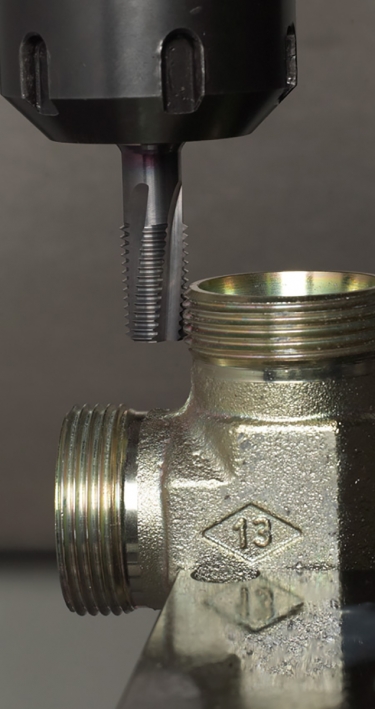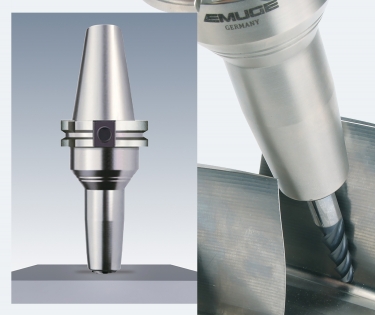Collets are among the most commonly found items in machine shops. However, even professionals who routinely use these toolholding mainstays may not know all the critical details about them.
This article dives into the intricacies of collets — from their design and types to how they compare with other toolholding options. It also covers the latest advancements in collet technology and provides tips for choosing and using collets to extend their lifespan and improve machining results.
How Does a Collet Work?
Placed in a chuck, a collet forms a collar around the tool or workpiece. The ER collet, the most widely used tool-clamping option, exerts clamping force through compression when tightened with a nut. ER collets are commonly used to hold tools like endmills, drills, taps, and reamers.
Comparing Collets to Other Toolholding Systems
Shrink-Fit Holders vs. ER Collets
Shrink-fit holders are designed for precision but come with limitations:
- Each holder is tailored for a specific tool diameter, requiring multiple holders for different tools.
- Shrink-fit systems also need a heating unit for tool installation, adding cost and complexity.
In contrast, ER collets are more versatile, as one holder can accommodate a variety of tool shank sizes.
Hydraulic and Milling Chucks
Hydraulic and milling chucks allow for straight reduction collets to adjust tool sizes. However, their performance is reduced compared to ER collets due to increased runout and decreased clamping force.
The Versatility of ER Collets
Alan Miller, engineering manager at BIG KAISER Precision Tooling Inc., explained that the main advantage of ER collets is their versatility. For example, an ER32 collet chuck can hold tool shanks ranging from 3.175 mm (0.125") to 19.05 mm (0.75") by simply swapping out collets.

ER collets offer compression flexibility but have limitations. Andy Moon, product manager for milling and toolholders at Guhring Inc., noted that this flexibility is limited to a small range — typically between 0.5 mm (0.02") and 1 mm.
When to Avoid ER Collets
ER collets are not ideal for high-torque cutting. Their compressibility, which provides flexibility, also introduces runout and instability, making them less suitable for heavy-duty machining.
“For high-performance applications, especially in milling, I generally steer people away from an ER collet chuck,” Moon said.
However, for light milling or finishing tasks, ER collets remain an excellent choice. Matching collet size to the tool shank diameter is critical for optimal performance.
Innovations in Collet Technology
FPC Collets
Emuge Corp.’s FPC collets are designed for precision with minimal flexibility. They conform to ISO H6-H9 standards and fit one specific tool diameter. The newly introduced Slim Line models address challenges in confined workspaces, especially for five-axis machining.

BIG KAISER’s Perfect Seal and Perfect Jet Collets
BIG KAISER Precision Tooling introduced Perfect Seal and Perfect Jet collets for hydraulic chucks:
- Perfect Seal: Seals the tool shank to allow high-pressure coolant flow.
- Perfect Jet: Improves coolant delivery along the tool shaft by reducing clearance between the collet and tool.

Best Practices for Collet Maintenance
Proper maintenance can significantly extend the life of collets and improve machining results. Here are some do’s and don’ts:
Do’s
- Clean Regularly: Use an air hose to remove debris from the collet and chuck during tool changes.
- Inspect Visually: Discard any collets or toolholders showing signs of wear or damage.
- Match Sizes: Always use a collet size that matches the tool shank diameter.
Don’ts
- Don’t Over-Tighten: Excessive tightening can stress and deform the collet and nut.
- Don’t Overextend Tools: Avoid pushing tools too far out of the holder, as this reduces gripping force and stability.
FAQs About Collets
What is a Collet Used For?
Collets are used for securely holding tools or workpieces in machining tasks, such as milling, drilling, and reaming.
What are the Different Types of Collets?
Types include ER collets, FPC collets, shrink-fit holders, and hydraulic chucks, each with unique strengths and applications.
How Do I Choose the Right Collet?
Base your choice on tool size, required clamping force, and machining application. ER collets are versatile, while hydraulic and shrink-fit chucks are better for precision work.
Contact Details
Contact Details
Contact Details
Related Glossary Terms
- chuck
chuck
Workholding device that affixes to a mill, lathe or drill-press spindle. It holds a tool or workpiece by one end, allowing it to be rotated. May also be fitted to the machine table to hold a workpiece. Two or more adjustable jaws actually hold the tool or part. May be actuated manually, pneumatically, hydraulically or electrically. See collet.
- clearance
clearance
Space provided behind a tool’s land or relief to prevent rubbing and subsequent premature deterioration of the tool. See land; relief.
- collet
collet
Flexible-sided device that secures a tool or workpiece. Similar in function to a chuck, but can accommodate only a narrow size range. Typically provides greater gripping force and precision than a chuck. See chuck.
- coolant
coolant
Fluid that reduces temperature buildup at the tool/workpiece interface during machining. Normally takes the form of a liquid such as soluble or chemical mixtures (semisynthetic, synthetic) but can be pressurized air or other gas. Because of water’s ability to absorb great quantities of heat, it is widely used as a coolant and vehicle for various cutting compounds, with the water-to-compound ratio varying with the machining task. See cutting fluid; semisynthetic cutting fluid; soluble-oil cutting fluid; synthetic cutting fluid.
- gang cutting ( milling)
gang cutting ( milling)
Machining with several cutters mounted on a single arbor, generally for simultaneous cutting.
- milling
milling
Machining operation in which metal or other material is removed by applying power to a rotating cutter. In vertical milling, the cutting tool is mounted vertically on the spindle. In horizontal milling, the cutting tool is mounted horizontally, either directly on the spindle or on an arbor. Horizontal milling is further broken down into conventional milling, where the cutter rotates opposite the direction of feed, or “up” into the workpiece; and climb milling, where the cutter rotates in the direction of feed, or “down” into the workpiece. Milling operations include plane or surface milling, endmilling, facemilling, angle milling, form milling and profiling.
- milling machine ( mill)
milling machine ( mill)
Runs endmills and arbor-mounted milling cutters. Features include a head with a spindle that drives the cutters; a column, knee and table that provide motion in the three Cartesian axes; and a base that supports the components and houses the cutting-fluid pump and reservoir. The work is mounted on the table and fed into the rotating cutter or endmill to accomplish the milling steps; vertical milling machines also feed endmills into the work by means of a spindle-mounted quill. Models range from small manual machines to big bed-type and duplex mills. All take one of three basic forms: vertical, horizontal or convertible horizontal/vertical. Vertical machines may be knee-type (the table is mounted on a knee that can be elevated) or bed-type (the table is securely supported and only moves horizontally). In general, horizontal machines are bigger and more powerful, while vertical machines are lighter but more versatile and easier to set up and operate.
- shank
shank
Main body of a tool; the portion of a drill or similar end-held tool that fits into a collet, chuck or similar mounting device.
Contributors
BIG KAISER Precision Tooling Inc.
888-866-5776
www.bigkaiser.com
Emuge Corp.
800-323-3013
www.emuge.com
Guhring Inc.
800-776-6170
www.guhring.com





